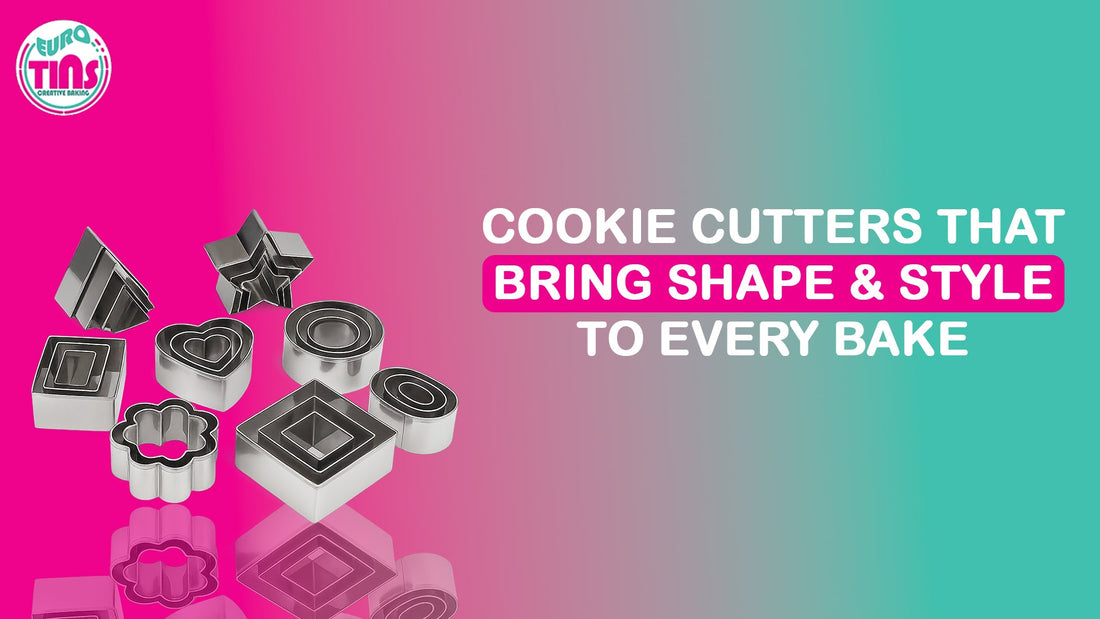Cookie cutters are more than just baking accessories. These simple tools bring artistry to everyday dough, helping you sculpt fun, elegance, and seasonal magic in your kitchen. Whether for a holiday celebration or a weekday treat, using the right cookie cutter makes the difference between plain and perfection. But their purpose goes far beyond cookies.
This article dives into the details of cookie cutters. You will uncover their many types, understand how to use them properly, discover their roles in decorating and crafting, and receive practical care advice. As you explore this guide, you will also learn why Eurotins stainless steel cookie cutters are trusted by both home bakers and professionals.
What Is a Cookie Cutter?
A cookie cutter is a handheld tool designed to press out uniform shapes from rolled dough. It enables bakers to create consistently shaped cookies without guesswork or manual shaping. Whether you are baking for fun, presentation, or portion control, cookie cutters offer precise results.
Besides making cookies look appealing, they save time and effort. Instead of molding each piece by hand, you simply press, lift, and repeat. The result is a tray of even, professional-looking treats ready to bake.
Types of Cookie Cutters
Cookie cutters are available in countless styles. From basic circles to elaborate seasonal motifs, you can find a cutter for nearly any theme or taste. Let us look closer at how they vary.
Shapes and Themes
Everyday Basics: Circles, stars, hearts, and squares offer timeless appeal and are perfect for all occasions.
Seasonal Motifs: Snowflakes for winter, pumpkins for fall, bunnies for Easter, and trees for Christmas bring festive flair.
Themed Designs: Animals, alphabets, and numbers are great for birthdays, baby showers, and educational fun.
Eurotins carries a wide range of both timeless classics and specialty-themed sets to match any celebration or creative idea.
Materials
Stainless Steel
-
Long-lasting, rust-resistant, and delivers sharp cuts
-
Safe for food and easy to wash
-
Maintains form through countless uses
Copper
-
Offers vintage appeal and precise shaping
-
Requires polishing and careful handling
Plastic
-
Lightweight, colorful, and safe for children
-
Not as sharp or durable
Others
-
Silicone cutters bend easily but are less common for shaping cookies
-
3D-printed cutters offer custom shapes, often used for crafts rather than baking
How to Use Cookie Cutters Like a Professional
Using a cookie cutter might seem simple, but technique matters. Follow these best practices for clean shapes and consistent bakes.
1. Preparing the Dough
-
Chill the dough before cutting to prevent sticking and spreading
-
Lightly dust your rolling pin, work surface, and cutter with flour
-
Roll the dough evenly for uniform baking
2. Cutting with Precision
-
Press straight down without twisting
-
Wiggle slightly, then lift carefully to avoid distorting the shape
-
Place cutouts close together to maximize dough usage
3. Handling Common Issues
-
Dough too sticky? Chill longer or add light flour
-
Delicate shapes? Use a flat spatula to transfer cutouts
-
Edges sticking? Brush the cutter with dry flour before each press
Beyond Baking: Other Creative Uses for Cookie Cutters
Cookie cutters are not limited to cookies. They can turn basic foods into visual treats and serve as versatile tools for crafting.
Culinary Uses
-
Cut sandwiches into stars or animals for kids’ lunchboxes
-
Shape pancakes, toast, or omelets into special figures
-
Create fruit and vegetable designs from melons or cheese
-
Form fondant or marzipan decorations for cakes
Craft and DIY Fun
-
Use as stencils for painting or card-making
-
Shape playdough or clay for crafts and ornaments
-
Trace outlines for salt dough keepsakes
Just be sure to keep kitchen cutters separate from craft-use ones to maintain hygiene.
Care and Maintenance: Keeping Your Cutters Sharp and Safe
Proper cleaning and storage extend the life of your cookie cutters, especially those made of high-grade stainless steel.
Washing
-
Hand wash with mild soap and warm water
-
Avoid using a dishwasher, as heat and detergents can dull metal
Drying
-
Dry immediately with a soft towel
-
Leave it out to air dry fully before storing to avoid rust or water spots
Storage
-
Keep cutters in a dedicated container or hang them neatly
-
Avoid bending by stacking carefully
Are Cookie Cutters Oven Safe? Metal cutters can withstand heat, but they are not intended for baking inside the oven. Plastic cutters should never be exposed to high temperatures.
Where to Find the Best Cookie Cutters
Look for well-crafted edges, a seamless build, and food-safe materials. A quality cutter should not bend under pressure or lose shape over time.
Eurotins stainless steel cutters meet all of these standards. Their collections feature durable construction, precise edges, and a wide array of designs for every project.
Conclusion
Cookie cutters are essential for bakers who value presentation, precision, and creativity. They go beyond function, offering a way to craft something memorable out of simple dough.
From elegant stainless steel cutters to fun holiday sets, Eurotins provides reliable tools built to last. Whether baking with children or preparing for an elegant event, the right cutter elevates your work.
Frequently Asked Questions
How do you use a cookie cutter?
First, ensure your dough is well-chilled and rolled to an even thickness on a lightly floured surface. Dust the cutter itself with a little flour, then press it straight down firmly into the dough. After pressing, gently wiggle the cutter a tiny bit to ensure a clean release before carefully lifting the shaped dough onto your baking sheet, leaving space between each piece.
How to use cookie cutters?
Begin by rolling your chilled dough to a consistent thickness; this ensures even baking for all your cutouts. Lightly flour your rolling pin and the cutter before firmly pressing straight down into the dough. To prevent sticking and distortion, use a thin spatula to transfer fragile cutouts carefully from your work surface to the baking sheet.
Are cookie cutters oven safe?
Most metal cookie cutters, including stainless steel ones, are indeed heat-resistant but are not typically designed to remain in the oven during baking. They are meant for shaping the dough before it goes into the oven. Plastic cutters, on the other hand, should never be placed in the oven as they will melt and release harmful fumes.
Where to buy a cookie cutter?
For high-quality and durable options, Eurotins is an excellent place to buy a cookie cutter. Their extensive collection features robust stainless steel designs that promise sharp cuts and long-lasting performance. You'll find a wide variety of shapes and sizes perfect for all your baking and crafting needs.
What is the best material for cookie cutters?
Stainless steel is widely considered the best material for cookie cutters due to its superior qualities. It provides sharp, clean cutting edges, is highly durable, rust-resistant, and completely food-safe. Stainless steel delivers more consistent and precise results compared to softer plastics or more reactive copper alternatives for everyday use.
Can I use cookie cutters for other foods?
Cookie cutters are incredibly versatile tools that extend far beyond just baking cookies. You can skillfully use them to shape items like sandwiches, cheese slices, pancakes, fruits, and vegetables for creative snacks. They are also perfect for making decorative elements from fondant for cakes or adding fun surprises to lunchboxes.
How do I clean my metal cookie cutters?
To ensure the longevity of your metal cookie cutters, always hand wash them immediately after use with warm, soapy water. It's crucial to dry them thoroughly with a cloth or paper towel right away to prevent any rust or water spots from forming. Avoid using dishwashers or abrasive cleaning tools, which can dull the edges or damage the finish over time.
What size cookie cutter should I use?
The ideal size for your cookie cutter depends largely on your specific recipe and the occasion or presentation you have in mind. Smaller cutters are perfect for creating bite-sized snacks, intricate designs, or for children's treats. Conversely, larger cutters are well-suited for themed displays, making a statement, or when you need a greater yield from your dough.
Why is the Heart cookie-cutter shape so popular for various celebrations?
The heart is a universal symbol of love, affection, and warmth, making the heart cookie cutter incredibly popular and versatile for numerous celebrations throughout the year. It's a staple for romantic occasions like Valentine's Day and anniversaries, and also widely used for weddings, engagement parties, and any event where you want to express care and affection through your baking. Its simple yet profound meaning resonates with many.
How to make a cookie cutter?
While it is possible to craft a basic cookie cutter at home using materials like aluminum foil strips or thin metal, these homemade versions often lack precision and durability. For consistently sharp cuts, reliable performance, and long-term use in all your baking endeavors, commercially manufactured cutters like those from Eurotins are highly recommended for their quality and design.




